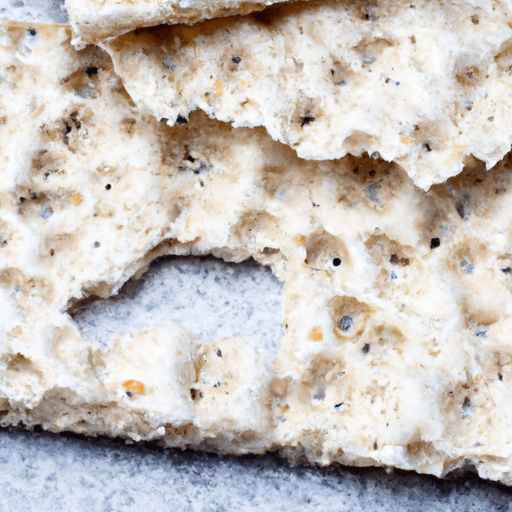The Wonderful World of Crisp Bread
Crisp bread, also known as knäckebröd, is a truly remarkable creation that has been enjoyed for centuries. This thin and crunchy bread has gained popularity across the globe due to its unique taste, versatility in cooking, and its impressive nutritional profile. Let’s delve into the captivating world of crisp bread and discover why it deserves a place in your pantry.
Taste and Texture
Crisp bread offers a delightful combination of flavors and textures that are simply addictive. Picture a thin, slightly coarse, and crispy base with a subtle nutty taste that is accentuated when toasted. This crispy texture provides a satisfying crunch and a lingering biscuity aftertaste.
Common Uses in Cooking
Crisp bread is a versatile ingredient that can be incorporated into countless dishes. Here are a few creative ways you can harness the magic of this bread in your culinary ventures:
Appetizers and Canapés
Crisp bread is a fantastic base for canapés and appetizers. Layer it with creamy spreads such as hummus, cream cheese, or smoked salmon spread. Top it with fresh herbs, sliced vegetables, or even cured meats for an elegant and satisfying bite.
Salad Toppings
Crumble crisp bread over salads to add a contrasting crispiness without overwhelming the flavors of the other ingredients. It can be a healthier alternative to croutons, providing a delightful textural contrast that enlivens your salads.
Sandwich Substitutes
If you’re looking for a low-carb option or simply want to switch things up, crisp bread can be a delicious substitute for traditional sandwich bread. Load it up with your favorite fillings, enjoy the satisfying crunch, and revel in a guilt-free meal.
Dessert Creations
Yes, even desserts can benefit from crisp bread! Crush it into coarse crumbs and layer it with vanilla cream or fruit compote to create a delightful and unexpected twist on a classic trifle or parfait.
Nutritional Benefits
In addition to its incredible taste and versatility, crisp bread packs a nutritious punch. Made primarily from whole grains, it offers numerous health benefits:
High Fiber Content: Crisp bread is an excellent source of dietary fiber, which aids digestion and helps maintain a healthy gut. It can also keep you feeling fuller for longer, making it a great snack option for weight management.
Low in Fat and Calories: Crisp bread is inherently low in fat and calories, making it an ideal choice for those seeking a healthier alternative to regular bread or crackers.
Packed with Minerals: Including essential minerals such as iron, magnesium, and zinc, crisp bread contributes to the body’s overall wellbeing.
History and Fun Facts
The roots of crisp bread can be traced back to ancient times, with evidence of similar bread-like products found in archaeological sites across Europe and the Middle East. However, it was the Swedish bakers who perfected the art of crisp bread, giving birth to the distinctive knäckebröd we know today.
Traditionally, crisp bread was baked using leftover dough, ensuring no wastage in times when resources were scarce. These thin, sturdy, and long-lasting loaves ensured that families had access to bread throughout the year, regardless of the climate or harvest conditions.
Today, numerous varieties of crisp bread can be found worldwide, featuring a wide range of flavors and added ingredients such as seeds, herbs, and spices. From the traditional Swedish knäckebröd to the Finnish ruisleipä and the Norwegian flatbrød, each culture has added its unique touch and flavors to this beloved staple.
Conclusion
Immerse yourself in the wonderful world of crisp bread and discover its distinct taste, versatility, and impressive nutritional benefits. Whether you incorporate it into appetizers, salads, or even desserts, crisp bread is sure to add a delightful crunch to your culinary experiences. So, why not grab a box today and embark on a culinary adventure that spans centuries?
Crisp Bread
Origin and History: Crisp bread, also known as hardtack or knäckebröd, originated in Scandinavia and has a history dating back to at least the Middle Ages. It was created as a way to preserve bread for long periods, particularly during harsh winters or long sea voyages. It was an essential staple for sailors and explorers due to its durability and long shelf life.
Common Uses: Crisp bread is a versatile ingredient that can be enjoyed in various ways. It is often eaten as a base for open-faced sandwiches, commonly topped with ingredients like cheese, smoked salmon, or cured meats. Crisp bread can also be used as a crunchy accompaniment to soups, salads, or dips. It provides a convenient alternative to regular bread and pairs well with both savory and sweet toppings.
Nutritional Benefits: Crisp bread offers several nutritional benefits. It is typically made from whole grains, such as rye, wheat, or barley, which provide essential dietary fiber. Additionally, it is usually low in fat and has a lower calorie content compared to traditional bread. Its low moisture content contributes to a longer shelf life and can help prevent spoilage.
Unique Properties: Crisp bread’s defining characteristic is its crispiness and dry texture. This is achieved through a unique baking process where the dough is rolled out very thinly and then baked at high temperatures to remove moisture. The resulting product is light, crunchy, and doesn’t contain any added fats or oils.
Historical Significance: Crisp bread has played a significant role in Scandinavian cuisine for centuries, particularly in Sweden, Norway, and Finland. It was an essential food source during times of scarcity and for long journeys, such as Viking expeditions. Today, it remains a beloved staple in Nordic cuisine and is enjoyed both domestically and internationally.
Please note that while crisp bread is generally a nutritious option, specific nutritional content may vary depending on the brand and recipe used.




Use the share button below if you liked it.
It makes me smile, when I see it.